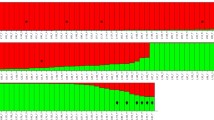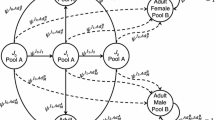Abstract
We used genetic methods to estimate the effective number of breeders (N b) in a population of Rana pretiosa, an imperiled amphibian in western North America. Microsatellite data was gathered from large samples of adults, eggs, and juveniles collected in 2006. We wished to determine where in the life cycle the greatest reductions in N b occur, and to compare genetic estimates of N b to an egg mass count estimate of the number of breeding adults. We predicted that N b estimated at the metamorph stage would be reduced by increased variance in family size due to egg mass mortality. Contrary to our prediction, estimates of N b at the egg and metamorph stages were similar. Thus, we found no evidence of inflated variance in family size between the two stages. If our results for this population are typical for R. pretiosa, then increased variance in family size during the egg to metamorph stage may not be a strong factor in reducing the effective population sizes (N e) relative to the census sizes (N) in this species.

Similar content being viewed by others
References
Araki H, Waples RS, Ardren WR, Cooper B, Blouin MS (2007) Effective population size of steelhead trout: influence of variance in reproductive success, hatchery programs, and genetic compensation between life-history forms. Mol Ecol 16:953–966
Aspi J, Roininen E, Kiiskilä J, Ruokonen M, Kojola I, Bljudnik L, Danilov P, Heikkinen S, Pulliainen E (2008) Genetic structure of the northwestern Russian wolf populations and gene flow between Russia and Finland. Conserv Genet. doi:10.1007/s10592-008-9642-x. http://dx.doi.org/10.1007/s10592-008-9642-x
Begon M (1979) Investigating animal abundance: capture-recapture for biologists. University Park Press, Baltimore
Berthier P, Beaumont MA, Cornuet J-M, Luikart G (2002) Likelihood-based estimation of the effective population size using temporal changes in allele frequencies: a genealogical approach. Genetics 160:741–751
Berven KA (1995) Population regulation in the wood frog, Rana sylvatica, from three diverse geographic localities. Aust J Ecol 20:385–392
Berven KA, Grudzien TA (1990) Dispersal in the wood frog (Rana sylvatica): implications for genetic population structure. Evolution 44(8):2047–2056
Blouin MS (2002) Genetic data for recovery of the oregon spotted frog, Rana pretiosa, in the Western United States, final report for USGS FY 2000 species at Risk Program project. USGS, Corvallis, Oregon
Blouin MS (2003) DNA-based methods for pedigree reconstruction and kinship analysis in natural populations. Trends Ecol Evol 18:503–511
Brede EG, Beebee TJ (2006) Large variations in the ratio of effective breeding and census population sizes between two species of pond-breeding anurans. Biol J Linn Soc 89:365–372
Briggs JL (1987) Breeding biology of the cascade frog, Rana cascadae, with Comparisons to R. aurora and R. pretiosa. Copeia 1987:241–245
Crouch WB, Paton PWC (2000) Using egg-mass counts to monitor wood frog populations. Wildl Soc Bull 28:895–901
Crow JF, Morton NE (1955) Measurement of gene frequency drift in small populations. Evolution 9:202–214
Cushman KA, Pearl CA (2007) A conservation assessment for the Oregon spotted frog (Rana pretiosa). USDA Forest Service and USDI Bureau of Land Management, Oregon
Durrant C, Beebee T, Greenaway F, Hill D (2008) Evidence of recent population bottlenecks and inbreeding in British populations of Bechstein’s bat, Myotis bechsteinii. Conserv Genet. doi:10.1007/s10592-008-9639-5. http://dx.doi.org/10.1007/s10592-008-9639-5
Easteal S (1985) The ecological genetics of introduced populations of the giant toad Bufo marinus. II. Effective population size. Genetics 110:107–122
Frankham R (1995) Effective population size/adult population size ratios in wildlife: a review. Genet Res 66:95–107
Funk WC, Blouin MS, Corn PS et al (2005) Population structure of Columbia spotted frogs (Rana luteiventris) is strongly affected by the landscape. Mol Ecol 14:483–496
Goudet J (2002) FSTAT version 2.9. 3.2, updated from Goudet (1995) FSTAT: a computer program to calculate F-statistics. J Hered 86:485–486
Hayes MP (1997) Status of the Oregon spotted frog (Rana pretiosa) in the Deschutes Basin and selected other systems in Oregon and northeastern California with a rangewide synopsis of the species’ status. Nature Conservancy under contract to the US Fish and Wildlife Service with assistance from the Oregon Department of Fish and Wildlife, Portland final report
Hill WG (1981) Estimation of effective population size from data on linkage disequilibrium. Genet Res 38:209–216
Hoffman EA, Schueler FW, Blouin MS (2004) Effective population sizes and temporal stability of genetic structure in Rana pipiens, the northern leopard frog. Evolution 58:2536–2545
Jorde PE, Ryman N (1995) Temporal allele frequency change and estimation of effective size in populations with overlapping generations. Genetics 139:1077–1090
Laurila A, Seppa P (1998) Multiple paternity in the common frog (Rana temporaria): genetic evidence from tadpole kin groups. Biol J Linn Soc 63:221–232
Leonard W, Hallock L, McAllister KR (1997) Natural history notes: Rana pretiosa (Oregon spotted frog). Behavior and reproduction. Herpetol Rev 28:86
Licht L (1969) Comparative breeding behavior of the red-legged frog (Rana aurora aurora) and the western spotted frog (Rana pretiosa pretiosa) in southwestern British Columbia. Can J Zool 47:1287–1299
Licht LE (1971) Breeding habits and embryonic thermal requirements of the frogs, Rana aurora aurora and Rana pretiosa pretiosa, in the Pacific Northwest. Ecology 52:116–124
McAllister KR, Leonard WP (1997) Washington state status report for the Oregon spotted frog, p. 38. Washington Department of Fish and Wildlife, Olympia
Merrell DJ (1968) A comparison of the estimated size and the “effective size” of breeding populations of the leopard frog, Rana pipiens. Evolution 22:274–283
Monsen KJ, Blouin MS (2003) Genetic structure in a montane ranid frog: restricted gene flow and nuclear-mitochondrial discordance. Mol Ecol 12:3275–3286
Nussbaum RA, Brodie ED Jr, Storm RM (1983) Amphibians and reptiles of the Pacific Northwest. University of Idaho Press, Moscow
Olson DH, Leonard WP (1997) Amphibian inventory and monitoring: a standardized approach for the PNW. In: Olson DH, Leonard WP, Bury RB (eds) Sampling amphibians in lentic habitats. Society for Northwestern Vertebrate Biology, Olympia, pp 1–21
Raymond M, Rousset F (1995) GENEPOP (version 1.2): population genetics Software for exact tests and ecumenicism. J Hered 86:248–249
Rowe G, Beebee T (2004) Reconciling genetic and demographic estimators of effective population size in the anuran amphibian Bufo calamita. Conserv Genet 5:287–298
Schmeller DS, Merila J (2007) Demographic and genetic estimates of effective population and breeding size in the amphibian Rana temporaria. Conserv Biol 21:142–151
Scribner KT, Arntzen JW, Burke T (1997) Effective number of breeding adults in Bufo bufo estimated from age-specific variation at minisatellite loci. Mol Ecol 6:701–712
Seburn D, Seburn C (2000) Conservation priorities for the amphibians and reptiles of Canada. Prepared for World Wildlife Fund Canada and the Canadian amphibian and reptile conservation network
Stuart SN, Chanson JS, Cox NA et al (2004) Status and trends of amphibian declines and extinctions worldwide. Science 306:1783–1786
Sugg DW, Chesser RK (1994) Effective population size with multiple paternity. Genetics 137:1147–1155
US Fish and Wildlife Service (2005) Species assessment and listing priority assessment form. Western Washington Fish and Wildlife Office, Lacey. Available at http://ecos.fws.gov/docs/candforms_pdf/r1/D02A_V01.pdf
Vieites D, Nieto-Román S, Barluenga M et al (2004) Post-mating clutch piracy in an amphibian. Nature Rev Genet 4:598–612
Waples RS (1989) A generalized approach for estimating effective population size from temporal changes in allele frequency. Genetics 121:379–391
Waples RS (1991) Genetic methods for estimating the effective size of cetacean populations. Rep Intern Whal Comm 13:279–300 (special issue)
Waples RS (2005) Genetic estimates of contemporary effective population size: to what time periods do the estimates apply? Mol Ecol 14:3335–3352
Waples RS (2006) A bias correction for estimates of effective population size based on linkage disequilibrium at unlinked gene loci. Conserv Genet 7:167–184
Waples RS, Do C (2007) LDNE: a program for estimating effective population size from data on linkage disequilibrium. Mol Ecol Resour 8:753–756
Watson JW, McAllister KR, Pierce DJ, Alvarado A (2000) Ecology of a remnant population of Oregon spotted frogs (Rana pretiosa) in thurston county, Washington. Washington Department of Fish and Game, Olympia
Wells K (1977) The social behaviour of anuran amphibians. Anim Behav 25:666–693
White GC, Burnham KP, Otis DL, Anderson (1978) Users manual for program. CAPTURE Utah State University Press, Logan
Acknowledgments
This research was conducted as part of Ivan Phillipsen’s PhD dissertation. We would like to thank Patty Stenberg for help in tissue collection. Robin Waples provided suggestions on the methodology and helpful comments on an early draft of the manuscript. Two anonymous reviewers also provided useful input on the manuscript. We thank the Oregon State University Center for Genome Research and Biocomputing (CGRB) for assistance with microsatellite genotyping.
Author information
Authors and Affiliations
Corresponding author
Rights and permissions
About this article
Cite this article
Phillipsen, I.C., Bowerman, J. & Blouin, M. Effective number of breeding adults in Oregon spotted frogs (Rana pretiosa): genetic estimates at two life stages. Conserv Genet 11, 737–745 (2010). https://doi.org/10.1007/s10592-009-9862-8
Received:
Accepted:
Published:
Issue Date:
DOI: https://doi.org/10.1007/s10592-009-9862-8




